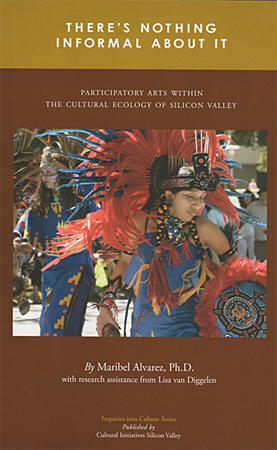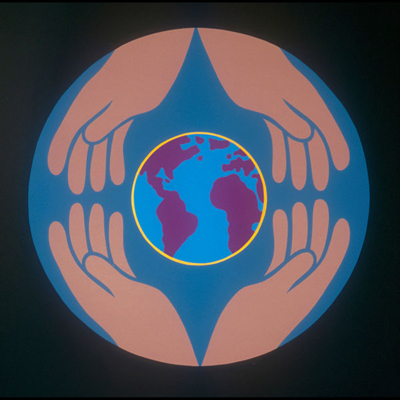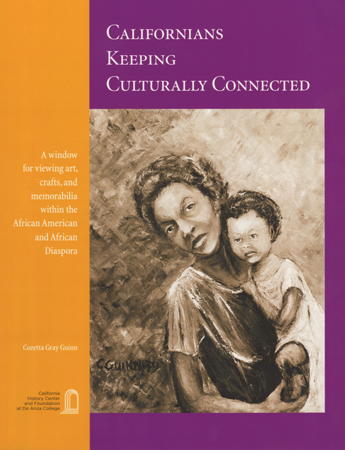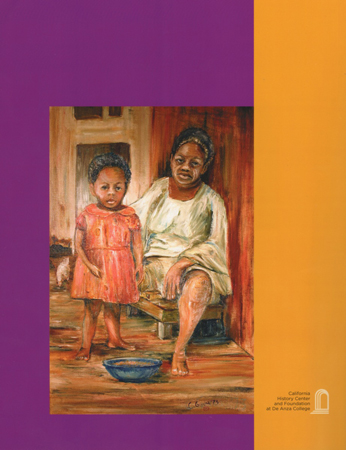 |
- Maribel Alvarez, Ph.D.
Excerpts from There's
Nothing Informal About It, Participatory Arts within the Cultural
Ecology of Silicon Valley, 2005, Maribel Alvarez, Ph.D.,
with research assistance from Lisa van Diggelen, published by
Cultural Initiatives Silicon Valley.
"The driving goal of this research was to imagine a Silicon Valley-based
initiative aimed at improving the ability of local residents to
engage in participatory arts, and what types of interventions
are most likely to accomplish this without altering the essential
informal and communitarian nature of these practices."

One of the recommendations: "Partnerships that broaden participation
and reverse the high/low distinction can be forged across a variety
of social registers, constituencies, and locations...art-making
at the crossroads of entrepreneurial, commercial, corporate, nonprofit,
and independent producers. The ideology that sustains the gap
that makes possible these bifurcations should be confronted intellectually
and pragmatically through imaginative undertakings by savvy, clever,
and highly principled organizations committed to making art "by"
the people, and not only art "for" the people.
Maribel Alvarez, Ph.D., is an
anthropologist, folklorist, curator, and community arts expert
who has documented the practice of more than a dozen of the country's
leading emerging and alternative artistic organizations. She holds
a dual appointment as Associate Research Professor in the English
Department and Associate Research Social Scientist at the Southwest
Center, University of Arizona. She was Executive Director (1996-2002)
of MACLA/Movimiento de Arte y Cultura Latino Americana, San José,
which she co-founded. Under her leadership, MACLA became nationally
recognized for the depth and innovations of its community arts
programs, and in 2001, the Andy Warhol Foundation for the Visual
Arts recognized MACLA as one of the most effective alternative
art spaces in the country.
While Cultural Initiatives Silicon Valley had a limited life (1996-2006)
and their website is no longer in existence, the study results
exist at CPANDA,
a national data archive.
Additional information and reports can be found on the Arts
Council Silicon Valley website.
- John Kreidler
Excerpts from his Preface for
There's Nothing Informal About
It, Participatory Arts within the Cultural Ecology of Silicon
Valley, 2005.
Art is an action that occurs in many places, by many people, and
for many reasons. Much art by professional artists and arts institutions
is presented in formal arts settings: concert halls, museums,
theaters, movie houses, and bookstores. However, much art is also
produced by everyday people in informal spaces not typically associated
with art: commercial storefronts, a street corner in East San
Jose, a downtown Vietnamese restaurant, and a coffeehouse in Campbell....
Overall, 81% of adults express an interest in the arts, and 37%
say that arts activities play a major role in their lives (John
Kreidler and Phil Trounstine, Creative
Community Index, Cultural Initiatives Silicon Valley, 2005).
As a means for understanding more about this wealth of participatory
culture, Cultural Initiatives commissioned...cultural anthropologist,
Dr. Maribel Alvarez, to conduct ethnographic field research in
Silicon Valley.... Dr. Alvarez explicitly sought out cases of
art-making in a range of commercial, non-commercial, as well as
nearly invisible settings, and found not only a breadth of motives,
but also a strong strain of arts made in conscious counterpoint
to the performances, exhibitions, and writings of professional
artists, and institutions.
Kreidler, Executive Director
of Cultural Initiatives Silicon Valley, 2000-2006, worked to implement
a ten-year cultural plan for Silicon Valley. Following is information
from his
2010 blog post about Cultural Initiative's final project,
Medici's Lever, 2009,
an online suite of two games and one simulation laboratory probing
regional cultural policy.
"The objective is to advance the cultural life of a regional metropolitan
area to new heights in which people, acting with deep cultural
knowledge, engage in an active cultural life that involves both
personal creativity and engagement with professionally produced
cultural goods and services.
"Cultural policy has been a backwater in the U.S., and for its
small circle of practitioners, it often has been focused on the
narrow issue of governmental funding for the arts. As one broadly
trained in public policy, I like to believe that the starting
point for a robust cultural policy should be the matter of advancing
the public's cultural interests. At several points over the past
30 years, I have written on this subject, commissioned others
to write about it, and developed computer simulations of cultural
policy."
Medici's Lever's purpose
is "to provide an interactive online learning laboratory for exploring
the complex interplay between culture, society, and the economy,
with emphasis on the role played by culture." One of the games
is entitled SJ Renaissance.
For more information see interview
or go directly to Medici's
Lever.
- Nancy Hom
Excerpt from "On Arts and Civic
Engagement," Nancy Hom. Written for a presentation and artist
panel at Euphrat Museum of Art, 1/24/06, with Sonja Manjon, Director,
Center for Art and Public Life, California College of Arts. In
conjunction with the exhibition Change
2005/2006.

Nancy Hom Culture
is the Seed, 1996. Mixed media 22"h x 22"w.
An artist who is concerned about civic engagement has to have
a willingness to try new things and a desire to connect with people.
Civic engagement in the arts starts with artists who understand
the importance of openness and interconnectedness between them
and the community.
At a time when people were very much into identity issues - around
ethnicity, sexual orientation, political issues, artistic disciplines,
etc. - I tried to stay open to other cultural influences and experimented
with different art forms. I painted murals with Latina artists,
mounted exhibits for an African American gallery, silkscreened
posters at Mission Graphica and in Japantown, danced in Carnaval,
read poetry at Asian American open mics. My artwork has served
many communities. Organizations that I've been associated with
since their inception include Asian American Women Artists Association,
Manilatown Heritage Foundation, Galeria de la Raza, Somarts Cultural
Center, and Kearny Street Workshop.
Wherever I go, whatever I do, I try to connect people and organizations
to each other. For example, when I was working as a curator at
the Western Addition Cultural Center in a predominately African
American neighborhood, I showed work by Japanese American artists
and produced concerts featuring African American and Japanese
American musicians. To get the elderly Japanese community to show
up at some openings, I hired people to escort the seniors into
the building.
I have been with Kearny Street Workshop for over 30 years and
served as its executive director for almost 9 years. It is the
oldest Asian Pacific American arts organization in the country.
Founded in 1972, our services include classes, workshops, publications,
exhibitions, presentations and readings. Education, art, innovation,
and community are the four cornerstones of KSW's programming.
Our main focus is to build community, using art to inform, celebrate,
challenge, and transform.
To feel responsible for, and be responsive to, the community takes
compassion, patience, understanding, a realization that we are
part of a bigger picture, a collective identity. That is the perspective
that I tried to instill at KSW, and one that continues to sustain
me. Since our beginnings in the International Hotel, we have used
art as a way to raise public awareness of historical and social
issues in the Asian Pacific American community. We have created
a space for artists and community members to interact, exchange
ideas and discover their common roots and identity.
Nancy Hom is an artist, writer,
curator, and arts consultant. She moved to San Francisco in 1974
and initiated ground-breaking projects for several non-profit
arts organizations, most notably Kearny Street Workshop, an Asian
American arts organization, of which she was executive director
from 1995-2003. For over three decades, Hom has produced numerous
images for community events and causes. Since 2010, she has created
large-scale installations using a variety of media. Awards include
the Gerbode Fellowship (1998), the KQED Local Hero Award (2003),
the Joan Mitchell Foundation Painters and Sculptors Award (2012)
and the SF Foundation's Helen Crocker Russell Award (2013).
For more information, visit www.nancyhomarts.com
and www.facebook.com/nancyhomartist.
- Cozetta Gray Guinn
Excerpts from Californians Keeping Culturally Connected, A window for viewing art, crafts, and memorabilia within the African American and African Diaspora, with selections from the 2002 exhibition, Cozetta Gray Guinn, 2012, published by the California History Center and Foundation, De Anza College.
Artist Cozetta Gray Guinn, elegant in her vintage chic, a lover of Delta Blues, is one of the pioneers in the development of an inclusive arts community in Silicon Valley. Californians Keeping Culturally Connected is ambitious as a community, arts, and educational tool with its history, timeline, and suggested readings. Guinn involves the college and community, including students in "their own words," addresses major social issues, and shares her own paintings and stories within an engaging process.
From the Introduction:
"... Soon, it was evident that within the collection there were bits of information and memorabilia historically linked, revealing that Californians were literally "holding on to" cultural history.
"Participants shared things that spoke to their identities, including such items as pottery, baskets, quilts, smoothing irons, tools, photographs, musical instruments, sheet music, books, legal documents, posters, and other cultural and utilitarian objects.... One commonality was that each item within the exhibit showed how tradition, customs and values were passed along to educate, inform and keep individuals connected to their pasts.

"Among the items collected were authentic bills of sale for slaves... photographs and a recently written history of a black pioneer family who came...in the mid 1850s [and the] adverse social/political climate in the Bay Area at that time... a page from a replica of the newspaper The Black Chronicle of July 25,1862, which described an event wherein a young slave, Robert Smalls, stole a Confederate gunboat and turned it over to the Union Navy...
"This exhibit was intended to expand on the Hughes-Meltzer concept of the African American experience in the United States (Pictorial History of the Negro in America, 1963, Langston Hughes and Milton Meltzer) by chronologically arranging documents, photographs, and three-dimensional objects...scenarios of a complex story within a given time frame. ... Contributors were an important aspect of the legacy inherent in the exhibit. In addition to telling individual stories that would merge into a single story, each lender, in his or her own way, has been a significant participant in the greater history of the place called Silicon Valley."
From the Epilogue:
"California Keeping Culturally Connected identifies factors that, when critically viewed, explain the importance of putting together this project conveying many stories... having a common strand, one of self-identity and what it means to be who we are. It is in part a record that validates the existence of individuals who lived and moved within the confines of the communities surrounding De Anza College in 2001. The...memorabilia...were communiqués dealing with social issues from the past and present. They represented a variety of themes that focused on achievements, joy, pleasure, and pride, as well as atrociousness, sadness, struggles, and the fight for justice.
"Reviewing the assorted images and stories in the exhibit has given me a broader insight into the social, economic, and political state of affairs that has permeated African American life for the past 300 years. Adding a chronology of events has been helpful in allowing me to see panoramically the time and context of the pieces displayed. ... The interconnected stories of war, slavery, freedom, economics, education, labor, lynching, music, theater, art and religion...."

Californians Keeping Culturally Connected, which took ten years to complete, is a labor of love. It is exemplary as a creative exploration of community connections in historical context. Artfully constructed, the book is like a painting. Says Guinn: "As a painter, I tell stories on canvas and on paper... [a form of] social realism...." While her quietly interspersed art, such as Sunday Morning at Bethel Church, 1984, propels the story, Guinn emphasizes the contributions of others. She stresses the importance of knowing both the individual cultural strands and the larger woven tapestry. We often don't know the people who live down the street.
In 1968, with her physicist husband, Isaac "Ike" Guinn, Cozetta introduced different cultural experiences to a valley loaded with white engineers. The couple established Nbari Art, a shop and museum-quality gallery in Los Altos, begun by connecting with students at Stanford and UC Berkeley. From a modest beginning, Nbari Art has shone for four decades as a cultural resource and a business featuring imported African art, African-American art, and Cozetta's own paintings.
Cozetta Gray Guinn, raised in rural Arkansas, attended a segregated Julius Rosenwald elementary school. Later, with a Master of Arts in Social Science from San Jose State University, she taught in the Cupertino Union School District at Hyde and Kennedy Middle Schools, determined to be inclusive. "All cultures," she says, "we did Alaska to Peru." She proudly asserts, "I taught Sheila Presley, now director of Art Education at the de Young Museum." She has always researched, e.g. in 1977, while volunteering for the National Museum of Nigeria, she helped develop a booklet, 2000 Years of Nigerian Art.
Guinn has continued to work as an artist, educator, and exhibition curator in all subsequent decades. In her various roles she calls on her experience to help others see and develop communal history. She has served as a volunteer and docent for The Mexican Museum, the de Young Museum, and the Legion of Honor. She is an instructor in the Intercultural/International Studies Department at De Anza College, a former board member of the Euphrat Museum of Art and the California History Center, and past coordinator of the Peninsula Book Club, an African American group promoting black authors since 1983.
|
| Copyright © 2013-25 Jan Rindfleisch. All rights reserved. |
|
